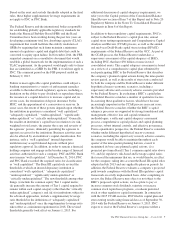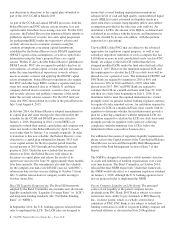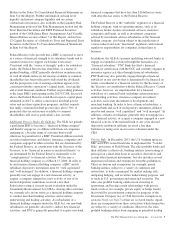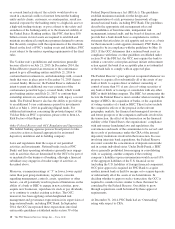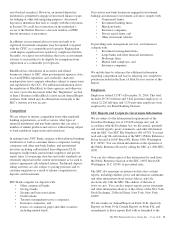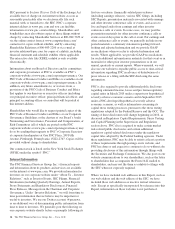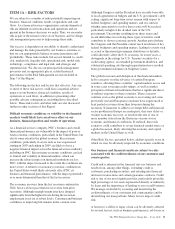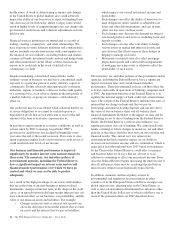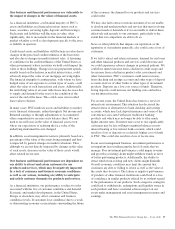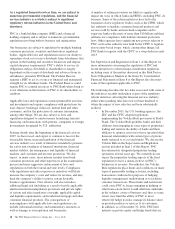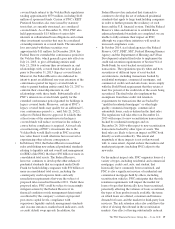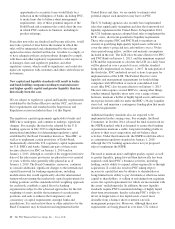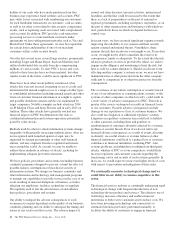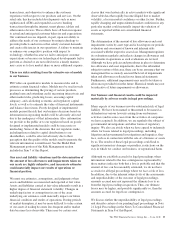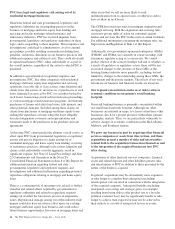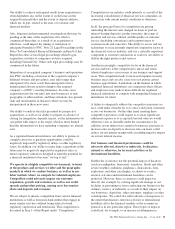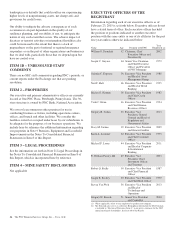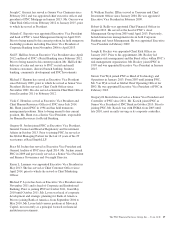PNC Bank 2014 Annual Report Download - page 35
Download and view the complete annual report
Please find page 35 of the 2014 PNC Bank annual report below. You can navigate through the pages in the report by either clicking on the pages listed below, or by using the keyword search tool below to find specific information within the annual report.Our business and financial performance are vulnerable to
the impact of changes in the values of financial assets.
As a financial institution, a substantial majority of PNC’s
assets and liabilities are financial in nature (items such as
loans, securities, servicing rights, deposits and borrowings).
Such assets and liabilities will fluctuate in value, often
significantly, due to movements in the financial markets or
market volatility as well as developments specific to the asset
or liability in question.
Credit-based assets and liabilities will fluctuate in value due to
changes in the perceived creditworthiness of the borrowers
and also due to changes in market interest rates. A lessening
of confidence in the creditworthiness of the United States or
other governments whose securities we hold could impact the
value of those holdings. Changes in loan prepayment speeds,
usually based on fluctuations in market interest rates, could
adversely impact the value of our mortgage servicing rights.
The financial strength of counterparties, with whom we have
hedged some of our exposure to certain types of assets, could
affect the value of such transactions and assets. Additionally,
the underlying value of an asset under lease may decrease due
to supply and demand for the asset or the condition of the
asset at the end of the lease. This could cause our recorded
lease value to decline.
In many cases, PNC marks its assets and liabilities to market
on its financial statements, either through its Net income and
Retained earnings or through adjustments to Accumulated
other comprehensive income on its balance sheet. We may
need to record losses in the value of financial assets even
where our expectation of realizing the face value of the
underlying instrument has not changed.
In addition, asset management revenue is primarily based on a
percentage of the value of the assets being managed and thus
is impacted by general changes in market valuations. Thus,
although we are not directly impacted by changes in the value
of such assets, decreases in the value of those assets would
affect related fee income.
Our business and financial performance are dependent on
our ability to attract and retain customers for our
products and services, which may be negatively impacted
by a lack of consumer and business economic confidence
as well as our actions, including our ability to anticipate
and satisfy customer demands for products and services.
As a financial institution, our performance is subject to risks
associated with the loss of customer confidence and demand.
Economic and market developments, in the United States,
Europe or elsewhere, may affect consumer and business
confidence levels. If customers lose confidence due to a weak
or deteriorating economy or uncertainty surrounding the future
of the economy, the demand for our products and services
could suffer.
We may also fail to attract or retain customers if we are unable
to develop and market products and services that meet evolving
customer needs or demands or if we are unable to deliver them
effectively and securely to our customers, particularly to the
extent that our competitors are able to do so.
News or other publicity that impairs our reputation, or the
reputation of our industry generally, also could cause a loss of
customers.
If we fail to attract and retain customers, demand for our loans
and other financial products and services could decrease and
we could experience adverse changes in payment patterns. We
could lose interest income from a decline in credit usage and
fee income from a decline in product sales, investments and
other transactions. PNC’s customers could remove money
from checking and savings accounts and other types of deposit
accounts in favor of other banks or other types of investment
products. Deposits are a low cost source of funds. Therefore,
losing deposits could increase our funding costs and reduce
our net interest income.
For several years, the United States has been in a very low
interest rate environment. This situation has decreased the
attractiveness of alternatives to bank checking and savings
accounts, which may lack deposit insurance and some of the
convenience associated with more traditional banking
products and which may no longer be able to offer much
higher interest rates. If interest rates were to rise significantly,
customers may be less willing to maintain balances in non-
interest bearing or low interest bank accounts, which could
result in a loss of deposits or a relatively higher cost of funds
to PNC. This could also result in a loss of fee income.
In our asset management business, investment performance is
an important factor influencing the level of assets that we
manage. Poor investment performance could impair revenue
and growth as existing clients might withdraw funds in favor
of better performing products. Additionally, the ability to
attract funds from existing and new clients might diminish.
Overall economic conditions may limit the amount that
customers are able or willing to invest as well as the value of
the assets they do invest. The failure or negative performance
of products of other financial institutions could lead to a loss
of confidence in similar products offered by us without regard
to the performance of our products. Such a negative contagion
could lead to withdrawals, redemptions and liquidity issues in
such products and have a material adverse impact on our
assets under management and asset management revenues and
earnings.
The PNC Financial Services Group, Inc. – Form 10-K 17


